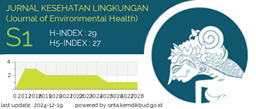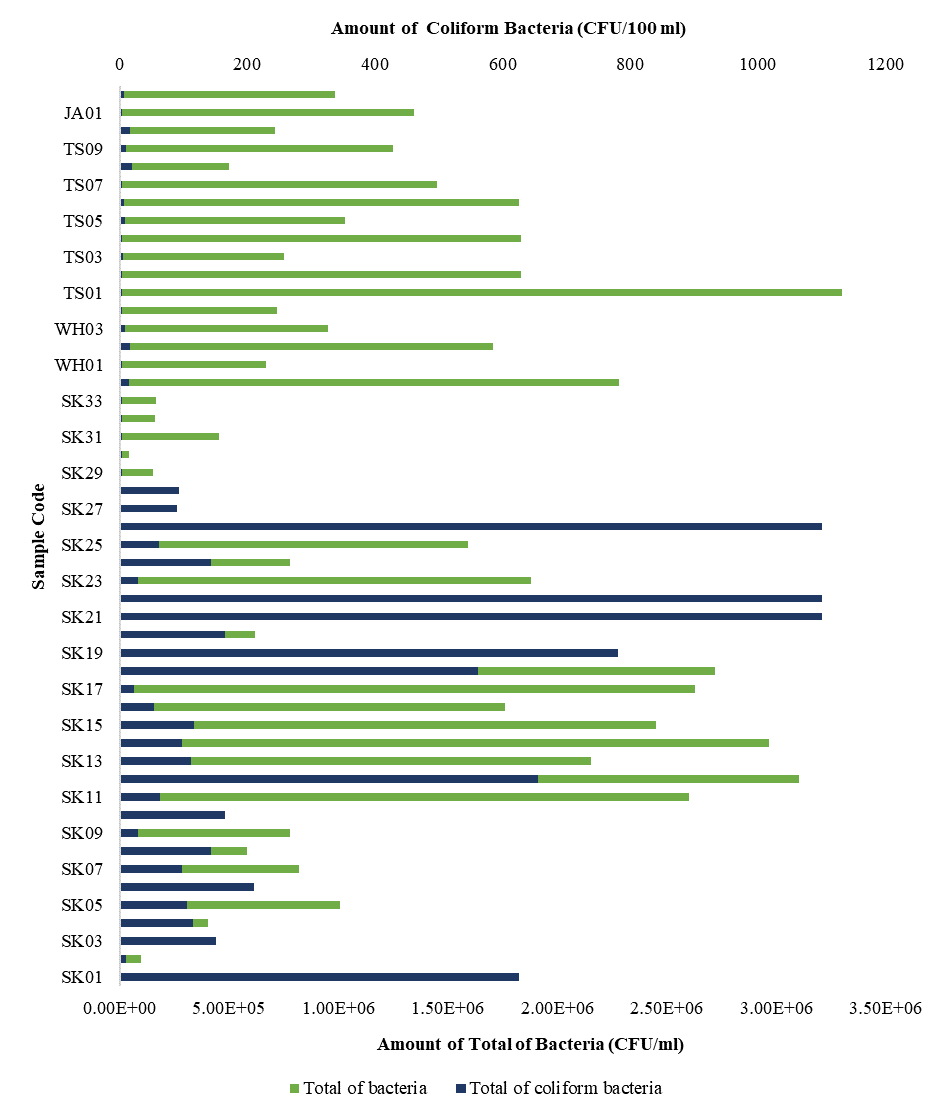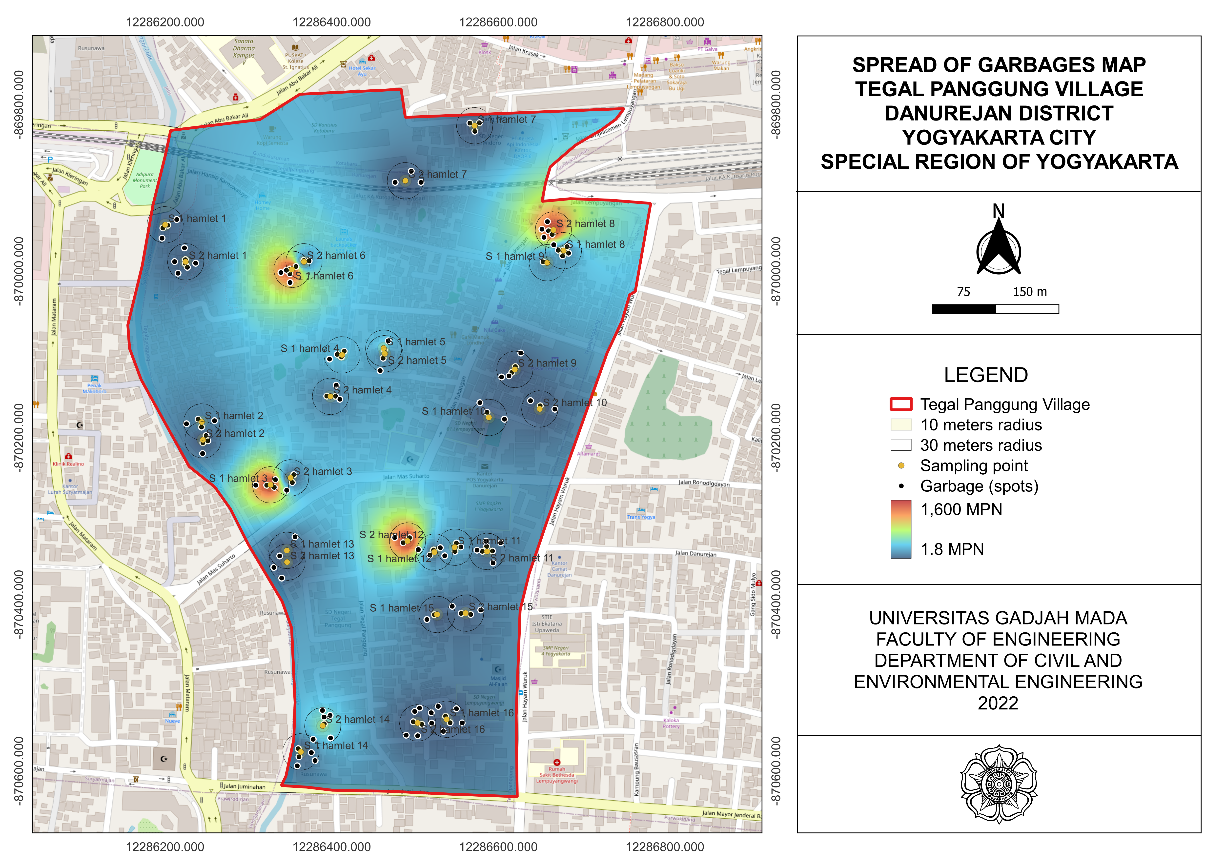A Spatial Analysis of Dengue Hemorrhagic Fever (DHF), Hygiene, and Latrines in Depok City in 2020

Introduction: Depok is one of the areas in West Java with an increasing Dengue Hemorrhagic Fever (DHF) trend. In 2017, 548 DHF cases were reported, and this increased to 1,276 cases in 2020. It is necessary to control and map influencing factors on DHF incidence to detect endemic areas and reduce its spread. Methods: This study was conducted to identify a spatial autocorrelation between DHF, hygiene, and clean latrines in Depok in 2020. The data were obtained from the Depok City's Health Profile published in 2020. The Moran's I and local indicator of spatial association (LISA) univariate and bivariate analysis methods were performed using the GeoDa application. Results and Discussion: DHF (Moran's I = 0.32), hygiene (Moran's I = 0.25) and clean latrines (Moran's I = 0.24) had a significant positive autocorrelation with the clustered pattern. This indicated that data patterns clustered had similar characteristics in the area. Villages in the high-high DHF incidence quadrant were Kukusan, East Beji, Beji, Tanah Baru, Kemirimuka, Depok, Pancoran Mas, and Depok Jaya. In general, there was no spatial autocorrelation neither between DHF and hygiene, nor DHF and clean latrines. However, in some urban villages, significant autocorrelations between these variables were discovered. Conclusion: DHF incidence in this study formed a clustered pattern. Influencing factors, such as hygiene and clean latrines, followed the same pattern. Besides that, a spatial autocorrelation was also apparent between DHF and hygiene, as well as DHF and clean latrines in several urban villages in Depok.
Centers for Disease Control and Prevention. West Nile Virus. United State: Centers for Disease Control and Prevention; 2021. http://www.cdc.gov/ncidod/dvbid/westnile/index.htm
Ministry of Health of Republic Indonesia. Latest DHF Case Data in Indonesia. Jakarta: Sehat Negeriku; 2021. https://sehatnegeriku.kemkes.go.id/
District Health Office of Depok. Health Profile of Depok City 2020. Depok: Depok City Health Office; 2020. https://diskes.jabarprov.go.id/
Pengestika RD. Hubungan Sanitasi Lingkungan dengan Kejadian DBD di Kelurahan Sendangguwo Wilayah Kerja Puskesmas Kedungmundu Kota Semarang. Dissertation. Semarang: University of Muhammadiyah Semarang; 2017.
Fuadzy H, Widawati M, Astuti EP, Prasetyowati H, Hendri J, Nurindra RW, et al. Risk Factors Associated with Dengue Incidence in Bandung, Indonesia: A Household Based Case-Control Study. Health Science Journal of Indonesia. 2020;11(1):45–51. https://doi.org/10.22435/hsji.v11i1.3150
Ridwan NM, Asmarani FL, Suwarsi S. Hubungan Tingkat Pengetahuan PHBS di Rumah Tangga dengan Pencegahan Penyakit DBD di Pedukuhan Wonocatur Banguntapan Bantul Yogyakarta. Jurnal Keperawatan Respati Yogyakarta. 2017;4(1):118–123. http://dx.doi.org/10.35842/jkry.v4i1.69
Indriawati L. Hubungan Perilaku Hidup Bersih dan Sehat (PHBS) terhadap Prevalensi Demam Berdarah Dengue (DBD) di Kecamatan Kedung Kandang. Skripsi. Malang: Universitas Muhammadiyah Malang; 2013.
Permana D, Zulasri H, Martha Z. Mapping The Number Of Dengue Fever Cases in West Sumatera Using Spatial Regression Analysis. International Journal of Progressive Sciences and Technologies (IJPSAT). 2021;29(2):131–141. http://dx.doi.org/10.52155/ijpsat.v29.2.3680
Achmadi UF. Manajemen Penyakit Lingkungan Berbasis Wilayah. National Public Health Journal. 2009;11(2):72–76. http://dx.doi.org/10.21109/kesmas.v3i4.217
Liu Y, Watson SC, Gettings JR, Lund RB, Nordone SK, Yabsley MJ, et al. A Bayesian Spatio-Temporal Model for Forecasting Anaplasma Species Seroprevalence in Domestic Dogs Within the Contiguous United States. PLoS ONE. 2017;12(7):1–18. https://doi.org/10.1371/journal.pone.0182028
Department of Population and Civil Registration in Depok City. Demografi Disdukcapil Kota Depok Tahun 2020 Semester 1. Depok: Department of Population and Civil Registration in Depok City; 2020. https://www.depok.go.id/demografi
Schabenberger O, A. Gotway C. Statistical Methods for Data Spatial Analysis. 1st ed. Boca Raton: CRC Press; 2017. https://doi.org/10.1201/9781315275086
Stephanie G. Moran's I: Definition, Examples. Jacksonville: Statistica How To; 2016. https://www.statisticshowto.com/morans-i/
Yasin H, Saputra R. Pemetaan Penyakit Demam Berdarah Dengue dengan Analisis Pola Spasial di Kabupaten Pekalongan. Media Statistika. 2013;6(24):27–36. https://doi.org/10.14710/medstat.6.1.27-36
Anselin L. Local Indicators of Spatial Association-LISA. Geographical Analysis. 1995;27(2):93–116. https://doi.org/10.1111/j.1538-4632.1995.tb00338.x
Livings M, Wu A-M. Local Measures of Spatial Association. The Geographic Information Science & Technology Body of Knowledge. United States: John P. Wilson; 2020. https://gistbok.ucgis.org/bok-topics/local-measures-spatial-association#Bivariate
Dewanti PF. Hubungan Keberadaan Jentik dan Perilaku dengan DDB di Wilayah Kerja Puskesmas Sawangan RW 03 Kelurahan Sawangan Lama Tahun 2018. Skripsi. Jakarta: Universitas Esa Unggul; 2018.
Ekawati N. Hubungan Tingkat Pengetahuan Warga Tentang Pencegahan Demam Berdarah Metode Ovitrap Dengan Angka Kejadian DBD di RT 01 Beji Depok Jawa Barat. Prosiding Seminar Nasional Hasil Penelitian & Pengabdian Kepada Masyarakat. 2020;1(1):1011–1018. http://openjournal.unpam.ac.id/index.php/Senan/article/view/8396
Lova C. Jumlah Pasien DBD di Depok Meningkat Hampir 7 Kali Lipat dari Tahun Sebelumnya. Kompas. 2019;1(1). https://megapolitan.kompas.com/read/2019/02/04/23404281/jumlah-pasien-dbd-di-depok-meningkat-hampir-7-kali-lipat-dari-tahun
Aryanthi DN. Hubungan Pengetahuan Tentang Kesehatan dan Pembinaan PHBS dengan Penerapan Perilaku Hidup Bersih dan Sehat (PHBS) pada Tatanan Rumah Tangga di Komplek RRI RT 02 RW 01 Kelurahan Cisalak Kecamatan Sukmajaya Kota Depok. Skripsi. Jakarta: Universitas Esa Unggul; 2017.
Handayani D. Hubungan Dukungan Keluarga dengan Penerapan Perilaku Hidup Bersih dan Sehat di Kelurahan Cisalak Pasar Cimanggis Kota Depok. Thesis. Jakarta: Universitas Indonesia; 2013.
Abie. PHBS dan Pengenalan Pokja Sehat dengan Masyarakat Kelurahan Sukmajaya. Kabar Indonesia. 2020;1(1). https://kabarindonesia.net/phbs-dan-pengenalan-pokja-sehat-dengan-masyarakat-kel-sukmajaya/
Syaifullah D. Kelurahan Rangkapanjaya Tentukan Arah Prioritas : Kesehatan yang Utama. Radardepok. 2021;1(1). https://www.radardepok.com/2021/06/kelurahan-rangkapanjaya-tentukan-arah-prioritas-kesehatan-yang-utama/
Permatasari CAE. Faktor Risiko Kejadian Gejala ISPA Ringan pada Baduta di Kelurahan Rangkapan Jaya Baru Tahun 2008. Skripsi. Depok: Universitas Indonesia; 2009. https://lib.ui.ac.id/abstrakpdf.jspdetail?id=126838&lokasi=lokal
Riyandanu MF. Hingga Tahun 2021, 41 Kelurahan di Kota Depok Deklarasikan Stop Buang Air Besar Sembarangan. Tribunnews. 2021;1(1). https://depok.tribunnews.com/2021/12/29/hingga-tahun-2021-41-kelurahan-di-kota-depok-deklarasikan-stop-buang-air-besar-sembarangan?page=all
Kesmas. Kriteria Jamban Sehat. Indonesian Public Health Portal. 2021; 1(1). https://www.indonesian-publichealth.com/jamban-sehat/
Riyandanu MF. Ribuan Keluarga Belum Dapat Akses Sanitasi Layak, Pemkot Depok Siapkan Anggaran untuk Bangun Jamban. Tribunnews. 2021;1(1). https://depok.tribunnews.com/ucnews/2021/12/29/ribuan-keluarga-belum-dapat-akses-sanitasi-layak-pemkot-depok-siapkan-anggaran-untuk-bangun-jamban?page=all
Ningrum KM. Kejadian Penyakit Demam Berdarah Dengue dengan Metode Kernel Density di Kecamatan Depok Tahun 2019. Skripsi. Surakarta: Universitas Muhammadiyah Surakarta; 2020.
Hasim MH, Hiong TG, Hatta M, Mutalip A, Mahmud AF, Lodz NA, et al. Spatial Density of Dengue Incidence : A Case Study of A Dengue Outbreak in Seksyen 7, Shah Alam. Int J Mosquito Res. 2018;5(2):9–14. https://www.semanticscholar.org/paper/Spatial-density-of-dengue-incidence%3A-A-case-study-a-Hasim-Hiong/fec8c83f181b520ce5e4b953789cf30d8725201f
Syamsir, Pangestuty DM. Autocorrelation of Spatial Based Dengue Hemorrhagic Fever Cases in Air Putih Area, Samarinda City. Jurnal Kesehatan Lingkungan. 2020;12(2):78-86. https://doi.org/10.20473/jkl.v12i2.2020.78-86
Rabiu M, El-Gasim G, Al-Sheik M. Spatial Pattern of Insanitary Toilet Facility in Nigerian States and Federal Capital Territory Using GIS Pattern Analysis. Journal of Geography, Environment and Earth Science International. 2018;15(1):1–10. https://doi.org/10.9734/JGEESI/2018/40515
Damtew YT, Geremew A. Households with Unimproved Water Sources in Ethiopia: Spatial Variation and Point-Of-Use Treatment Based on 2016 Demographic and Health Survey. Environmental Health and Preventive Medicine. 2020;25(81):1–11. https://doi.org/10.1186/s12199-020-00921-1
Chaudhuri S, Roy M, Jain A. Appraisal of Wash (Water-Sanitation-Hygiene) Infrastructure Using A Composite Index, Spatial Algorithms and Sociodemographic Correlates in Rural India. Journal of Environmental Informatics. 2020;35(1):1–22. https://doi.org/10.3808/jei.201800398
Mutheneni SR, Mopuri R, Naish S. Spatial Distribution and Cluster Analysis of Dengue Using Self Organizing Maps in Andhra Pradesh, India, 2011 – 2013. Parasite Epidemiology and Control. 2018;3(1):52–61. https://doi.org/10.1016/j.parepi.2016.11.001
Fatati IF, Wijayanto H, Sholeh AM. Analisis Regresi Spasial dan Pola Penyebaran Pada Kasus Demam Berdarah Dengue (DBD) di Provinsi Jawa Tengah. Media Statistika. 2017;10(2):95-105. https://doi.org/10.14710/medstat.10.2.95-105
World Health Organization and The Health and Environment Linkages Initiave. Better Environmental Management for Control of Dengue. Geneva: World Health Organization; 2020. https://www.who.int/heli/risks/vectors/denguecontrol/en/
Pratiwi TS, Wikurendra EA, Yudhastuti R, Mirasa YA. Preventive Behavior Towards Maya Index at DHF Endemic Area. Jurnal Kesehatan Lingkungan. 2021;13(1):1-8. https://doi.org/10.20473/jkl.v13i1.2021.1-8
Junias MS, Radja Riwu Y. Housewives Behavior in Effort to Overcome Dengue Fever. Journal of Health and Behavioral Science. 2020;2(3):148–163. https://doi.org/10.35508/jhbs.v2i3.2333
Copyright (c) 2022 JURNAL KESEHATAN LINGKUNGAN

This work is licensed under a Creative Commons Attribution-NonCommercial-ShareAlike 4.0 International License.
1. Copyright of all journal manuscripts is held by the Jurnal Kesehatan Lingkungan.2. Formal legal provisions to access digital articles of electronic journal are subject to the provision of the Creative Commons Attribution-ShareAlike license (CC BY-NC-SA), which means that Jurnal Kesehatan Lingkungan is rightful to keep, transfer media/format, manage in the form of databases, maintain, and publish articles.
3. Published manuscripts both printed and electronic are open access for educational, research, and library purposes. Additionally, the editorial board is not responsible for any violations of copyright law.
JKESLING by UNAIR is licensed under a Creative Commons Attribution-ShareAlike 4.0 International License.







































